|
June 21st 1942 :
Tobruk falls to Rommel. Rommel had, after a long and bitter struggle finally rid himself of the “thorn in his side”. He now had his sights on Alexandria.
Mad dogs and Englishmen go out in the mid-day sun
The Japanese don`t care to, the Chinese wouldn`t dare to
Hindus and Argentines sleep firmly from twelve to one
But Englishmen, detest a siesta.
Noel Coward, “Mad Dogs and Englishmen”
Very true Mr. Coward.
A.D.M.S Suez Sub Area. Quarterly Report. Second Quarter 1942. (WO 177/63)
Principal Diseases
On 22nd June 1942, a number of heatstroke and heat exhaustion cases were admitted to hospital. Cause of casualties :
(a) Poor condition of troops.
(b) Overcrowded ship (Queen Mary).
(c) Exceptionally hot day.
(d) Disembarkation during heat of day.
|
Details:
|
|
|
|
|
|
Officers
|
3
|
|
Other ranks
|
43
|
|
|
|
|
|
|
|
Other ranks
|
25
|
|
|
|
|
(Of these one died, four on D.I. list)
|
|
|
|
|
|
|
|
|
From - Train
|
1
|
|
Ship
|
26
|
|
Quay
|
10
|
|
March
|
34
|
|
Total
|
71
|
|
The Disembarkation Of Troops – 22.6.42. Appendix IV (WO177/63)
Between 1300hrs and 1700hrs approximately 2500 troops disembarked from G.G.450 (The Queen Mary) and landed at Shell jetty, the first party arriving at Shell jetty at approximately 1500hrs.No transport could be provided for personnel.
Kit bags and packs were carried in three ton lorries with trailers, units being instructed to make up baggage parties from those whom they thought could not stand the march. The remainder were to march approximately three and a half miles to 157 (Suez) Transit Camp. In actual fact many obtained “lifts” on the road.
Officers in charge of parties were instructed to march easily, rest as often as they considered necessary, to ensure that personnel loosened equipment at rest periods and that they did not drink.
Three ambulance cars were laid on, one at Shell jetty to collect casualties who had succumbed to the heat on the voyage from Transport to Shell Jetty, and two patrolled the road.
The sorting of casualties was done pertly at M.I. Room, Ataka North but mainly at M.I. Room, Suez Transit Camp.
It should be noted some 9000 troops were disembarked during the heat of the day and that the figures from 13 General Hospital include casualties picked up in the docks who had not marched at all. An endeavour is being made to obtain the necessary details of the casualties (marching on road) including medical category and age.
Cause: Disembarkation during heat of day of men who are not fit after being in cramped Quarters for over a month, in this case a quick turn round necessitated disembarkation in the heat.
Marching was not approved of by this office, but it was explained by Headquarters, Suez Sub Area as essential owing to lack of transport.
Future:
Depends on military situation .
Should be less crowding on transports .
Disembarkation at leisure , i.e. In early morning or in the evening.
Provision of transport on shore.
Mr. Alec Adamson. RAMC. :
There were quite a few cases of heat stroke and sun stroke and helmets had to be worn from April to September, between 09.00 hours and 16.00 hours. We used to put heat stroke patients into sheets soaked in iced water until their temperature came down to a safe level.
Among those disembarking from the Queen Mary that day had been Jimmy Buxton. Jimmy, an Air-Frame fitter serving with the RAF, was on his way to 107 M.U. Kasfareet.
During my research for Albert`s War, I have made the acquaintance of Jimmy`s nephew, Derek Buxton. Derek is looking into his uncle Jimmy`s RAF days, just as I am looking into Albert`s Army days.
Jimmy Buxton was to later train as an Air Gunner. Sadly Jimmy was killed in action, just a fortnight before the end of the war.
June 23rd 1942 :
Two days after the capture of Tobruk, Rommel and the Afrika Korps cross the frontier into Egypt with a view to securing Alexandria and the Suez Canal. General Auchinleck and the British Eighth Army withdraw to prepare a defensive line at El Alamein, just 65 miles to the west of Alexandria.
This frontier crossing gave rise to the infamous “Ash Wednesday”, the day when G.H.Q. in Cairo, a.k.a “The Short Range Shepheard`s Group” burnt many of its secret files ahead of Rommel`s advance and Cairo was treated to a rain of ash.
July 1st 1942 :
Rommel`s forces attack the El Alamein line. A series of hard fought encounters follow, with each side receiving reinforcements, though neither side was strong enough to impose its will on the other. By the 27th of July both armies were exhausted and the first battle of El Alamein had ended in apparent stalemate.
A.D.M.S Suez Sub Area. Quarterly Report. Second Quarter 1942. (WO 177/63)
Embarkation Duties.
Embarkation. A total of 5,048 invalids have been embarked on Hospital ships and ordinary transports during the quarter.
Disembarkation. 44 troopships passed through Suez. 965 sick transfers were removed from these.
Medical Stores. The Embarkation Sub Depot of Medical Stores, Suez, has supplied Hospital ships and ordinary transports with equipment, stationery and comforts. The stocks held by this Sub Depot have been increased and indents submitted to double the original scale of 12 Hospital ships and 12 Transports.
A refrigerator is needed for the preservation of vaccines and sera.
A close watch has been kept on quays and jetties for Medical Stores, and instructions given for the disposal of any items which have been found. There are no outstanding items anywhere on the Suez Docks at the present time.
Establishment.
Personnel. It is recommended that six RAMC orderlies, extra to establishment, be posted to No 13 General Hospital for duty as train orderlies on special trains carrying troops. Under present arrangements O.C. 13 General Hospital supplies orderlies when necessary, equipment for whom is provided by the E.M.O. to whom it is returned on completion of the journey. As many as nine orderlies may be required in one day.
Transport. There is urgent need for at least a 15cwt. truck for conveyance of stores, which are of necessity required at very short notice, and also small numbers of invalids, trooping parties and individual RAMC personnel, for all of whom transport has to be arranged by the E.M.O.. Much valuable time is wasted in searching for transport, and invalids have been kept waiting in the heat. Hospital trains and ordinary passenger trains conveying ward coaches have to be met and invalids documents etc. collected. This could not be done on the motorcycle if it were available. Also, at present the only means of communication with the Medical Stores (the other side of Suez) is by requesting someone proceeding to No 13 General Hospital to leave a message, or being fortunate enough to borrow some transport for this purpose.
It is recommended that if it is not possible for transport to be allotted to the Embarkation Staff a standing detail of one truck be obtained from the Officer i/c Transport.
The tug “Ivy” is still the only water transport available for the E.M.O.
Equipment.
The services of a telephone for the E.M.O. are urgently required; or at least a share of one which does not necessitate a detour before the instrument is reached.
August 12th 1942 :
Churchill appoints Lieutenant General Bernard L. Montgomery to command the British Eighth Army.
A.D.M.S Suez Sub Area. Quarterly Report. Third Quarter 1942. (WO 177/63)
Medical Units.
No. 13 General Hospital has expanded to 1600 beds of which 100 are allocated to No. 6 V.D.T.C.
Transport.
The transport problem is still a difficult one as the truck on loan to Medical branch not only serves the A.D.M.S., D.A.D.H., and E.M.O., but also acts as duty car to the H.Q. every third day.
The Sub Area Malarial Officer has no transport.
Personnel in the Sub Area .
These are mainly technical units with the necessary defence troops. Approximate daily strength :-
|
Imperial and Dominion Troops
|
16,000
|
|
Native Artisans/ Labourers
|
16,393
|
|
Total
|
32,393
|
|
|
|
|
|
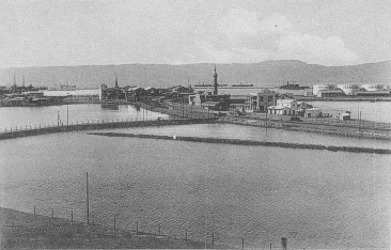
|
|
Suez Panoramic View of Terre-plein
|
|
Embarkation Duties.
(a) Total of 6,621 Class “A” and Class “B” invalids have been evacuated during the quarter on 13 Hospital Ships and 19 Ordinary Transports.
(b) 60 large hired transports arrived during the quarter. 770 sick were removed from these.
(c) 93 indents were supplied to ships during this period and several ships were completely equipped with stores by Sub Depot Medical Stores. A refrigerator has now been installed in the Sub Depot, and there is adequate storage for vaccines and sera.
(d) Approximately 440 tons dead weight of unaccompanied medical stores have arrived at this port. The off-loading and despatch of these stores has been supervised by RAMC personnel, and as the majority of stores are unloaded in the Roads and taken by lighter to any of ten different quays, which in certain instances are many miles apart, makes this procedure a difficult one, and it has been necessary to obtain the services of extra personnel for these duties. All medical stores are despatched from Suez as quickly as possible by rail or M.T., the policy being to clear the quays immediately the stores arrive. Arrangements have been made with Officer i/c Transport , 80 Sub Area, that notification is given to this office whenever a truck is returning to Cairo or Tel-el-Kebir and requires a load.
(e) A small supply of ordnance stores is held at Port Tewfik for issue to Hospital Ships and Transports. Difficulty is experienced when troopships arrive with large quantities of Hospital linen which require washing; the ships do not usually stay long enough to enable this to be done and it is seldom possible to exchange all the articles, as the numbers are too large.
(f) The need for a truck for the conveyance of stores and personnel has become greater during the past few months. The purposes for which a truck is required are – the conveyance of medical stores to and from the Sub Depot, the conveyance of stores between the different quays in Port Tewfik, Suez, Refinery Breakwater, and Ataka, for meeting invalids and RAMC personnel with baggage at Port Tewfik Station and conveying them to the Hospital or the quayside, and for the walking patients and baggage evacuated from troopships in the Roads. Many hours are wasted searching for transport for any of the above purposes, and the services of a 3-ton truck can be utilised every day.
(g) It is recommended that additional RAMC personnel be attached to 80 Sub Area or No. 13 General Hospital for duties as train orderlies, and to accompany medical stores to their destinations, and to serve as a nucleus for provision of extra mental escort for Hospital Ships where necessary. A small pool of RAMC personnel could be well utilised for duties of this nature.
October 23rd 1942.
Montgomery starts the last and decisive British campaign against Axis forces in Egypt. The second battle of El Alamein. A massive artillery bombardment precedes the advance of first infantry then armour through the German and Italian lines.
The battle of El Alamein was not the end, Churchill told the House of Commons a few days after the Eighth Army`s great victory. “ It is not even the beginning of the end. But it is perhaps, the end of the beginning”, he said.
|
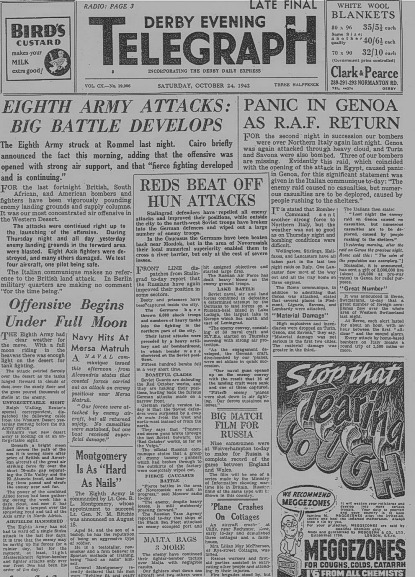
|
|
How Derby Read The News
|
|
A.D.M.S Suez Sub Area. Quarterly Report. Fourth Quarter 1942. (WO 177/63)
Embarkation Duties.
40 large hired transports arrived at this port during the last quarter, and all of them were visited on arrival, and arrangements made for disposal of the sick of all the branches of the Service, including Allied Forces and Merchant Seamen. Medical trooping parties were arranged in certain instances and medical stores and stationery supplied where necessary. A total of 696 sick were transferred to Hospital ashore.
The following medical personnel have been attached to Docks Operating Companies on various quays to check and supervise the off-loading of medical stores from freight-ships, to ensure their safe stowage on quays, and to arrange for quick despatch to consignees –
Port Tewfik Docksone Sergeant and two Privates
El Shatt Quayone Corporal and one Private
Attaka Docksone Corporal and one Private
Invalids have been embarked on 12 Hospital Ships and 15 transports. A total of 5,476 Class “A” and Class “B” invalids in all have been evacuated.
A.D.M.S Suez Sub Area. Quarterly Report. First Quarter 1943 (WO 177/63)
Embarkation Duties.
(a) 28 transports arrived at this port during the last quarter, and all of them were visited on arrival, and arrangements made for disposal of the sick of all branches of the service, including Allied Forces and Merchant Seamen. Medical trooping parties were arranged in certain instances and medical stores and stationery supplied where necessary.
In addition to the above, refugees have been disembarked from transports and arrangements made for suitable accommodation of sick on special trains. 695 Italian Prisoners of War have been disembarked from transports and Hospital Ships, for repatriation.
(b) Sub Depot Medical Stores. 49 Indents were supplied to ships during this period – 39 to hired transports (including 8 to vessels carrying A.I.F. and N.Z.E.F. personnel), 4 to Hospital Ships, and 6 to other vessels. 20 indents have been received. All vouchers in respect of issues and receipts during the quarter have been called for by the Financial Adviser M.E.F., and have been rendered.
|
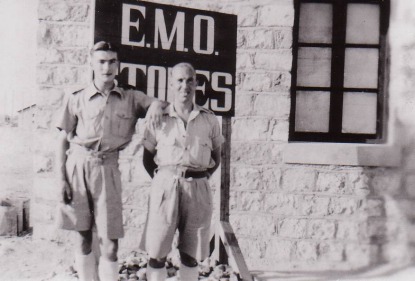
|
|
The Sub Depot Medical Stores
|
|
(Albert Standing Right)
|
|
(c) Evacuation of Invalids. Invalids have been embarked on 7 Hospital Ships and 10 Ordinary Transports. A total of 3,036 Class “A” and Class ”B” invalids in all have been evacuated.
(d) Ordnance Stores. Certain items of Ordnance Stores, including mosquito cream, water sterilising tablets, etc., Hospital clothing, are held.
(e) Officers under Training. Five Medical Officers have been attached to this Headquarters during the past three months, for training in the duties of Embarkation Medical Officer.
|
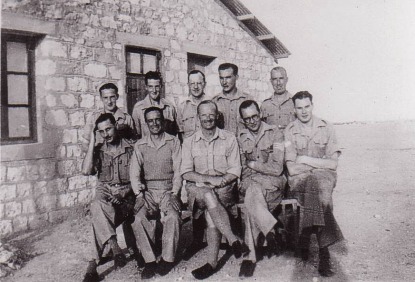
|
|
The Staff Of The Embarkation Medical Officer, 80 Sub Area
|
|
(Albert, Standing Back Right)
|
|
“everyone knows there is sand in Egypt”
Nearly eight weeks after we had left Britain, the ship anchored in Suez. I had expected sand – everyone knows there is sand in Egypt – but I had not thought about sand that covered everything, a thin layer that filmed the skin, nose and mouth. We stood beside our baggage on the dockside in the full heat of the noonday sun. “Keep in the shade, ladies”, a port official said as he hurried past. Shade : there seemed little enough of that here.
Betty Parkin “Desert Nurse”
Mr. C.N. King. RAMC :
For several days every year (I can`t remember which month) there would be the Khamsin, a very strong wind bringing with it sand that would get everywhere.
Mr. Tommy Evans. Royal Artillery:
The Khamsin, was known to the Afrika Korps as the “Ghibli”. The approaching storm could be seen coming, visible from several miles away, a wall of sand and dust two or three hundred feet high. The sky darkened and in no time at all it would be upon you, a ferocious sandstorm which could last for up to three days, preventing all movement of men and vehicles. You just had to keep your head down and protect yourself as best as you could.
Sun, Sand and yes more Shitehawks. Shitehawks, like Port Said, Suez and the Sweetwater Canal, are a familiar name from my youth. I have since learned, that they were actually and still are black kites, a type of vulture with a three foot wing span, and they were crafty, as Marjorie Bennett recalled in Eric Taylor`s book “Wartime Nurse”.
Around noon they would gather and perch on the kitchen roof. The hospital meals were cooked in a field kitchen away from the wards, and when the bugle sounded at mid-day “Come to the cookhouse door, boys, come to the cookhouse door”, off would go the orderlies and a few of the “up patients” to deliver the grub to the wards. So, when the food was dished up and taken to the patients on trays, those darned kite birds would swoop down and the poor orderlies would drop the lot. Now food, like water, was in short supply, and we too became quite crafty. Just before noon we would send two POWs with garbage pails to the refuse pit. The kite birds would follow and rummage around whilst we quickly dished up the dinners before the birds got back to the kitchen roof.
Frank Munro served with 205 Group R.A.F, in the Middle East, as a wireless operator on Wellington bombers. Frank shares a few of his Middle East memories.
Mr. Frank Munro.205 Group. R.A.F. :
Disembarking from the “Stirling Castle”, January 1944 at Port Said, we were put onto a train which would take us to Cairo. Shortly after leaving the dock area I remember seeing for the first time real camels and on the water several Arab dhows, just like the pictures in my school books. We arrived on the outskirts of Cairo well after dark, we saw many small fires burning where people were cooking their food, the smell – Ye Gods! but we soon became used to it. We were moved from the station in Cairo to a large hotel on the outskirts of the city which was being used as an Aircrew Reception Centre.
The following morning when looking out of our third floor window, we saw these quite large birds floating about around the area. On asking what they were called, we learned from a member of the permanent R.A.F. staff, that they were called “Shitehawks”. So from that day onwards, whenever I see them on television mostly in India but sometimes around the Middle East, they are still “Shitehawks” and I have a quiet smile to myself – I remember them well !!
Albert`s Army Service/Pay Book records very little detail of his time in the Canal Zone, besides those of routine inoculations. It does however record that on the 12th of March 1943, a special leave warrant was issued to Albert . There are no details of the duration of this leave, nor do I have any firm clue as to where he would have enjoyed it, but I do have an indication though, of how he would have spent some of his leave, thanks to one of few photos that Albert bought back with him from Egypt .
|
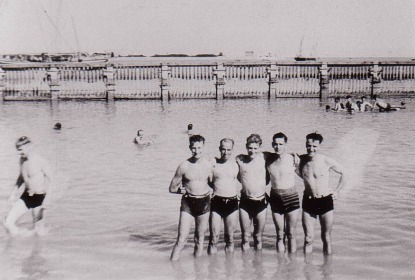
|
|
A Welcome Break
|
|
Albert second from the left (main group)
|
|
I would hazard a guess, at the location being Port Said, but it could very well be any number of places, Ismailia, Port Tewfik or even Alexandria.
Mr. Alec Adamson. RAMC. :
Having left Quassassin at 6.30 a.m. we reached Alexandria at about 2.30 p.m. and were taken to 154 Transit Camp at Sidi Bishr on the coast near to the city. We were paid and let loose the next day. We wined and dined around the city but our finances could only stand a day or two at Alexandria`s prices. On one day, by clubbing together, we were able to hire a taxi and tour round some of the tourist attractions of the city. King Farouk had a palace which we were able to visit (the outside only), the next was the zoo and then pompey`s pillar with the catacombs below. That was where our money ran out. The Y.M.C.A. provided us with comfortable surroundings and good cheap, wholesome food as did the N.A.A.F.I. Generally it was safer to eat in such places because of the danger of food poisoning. We went to several cabarets but their floor shows and food were very poor value for money and not really worth visiting. We took one or two trips in the horse- drawn carriages known as gharries. There were several cinemas showing English-speaking films and they were very popular. After the last showing of the programme the Egyptian national anthem was played and we had a very rude parody on it which we bawled out. In it was a recommendation as to what King Farouk should do with his private parts !! We could also travel fairly cheaply by trams which came right past our barracks. The accommodation we had was a peace-time barracks and as such, had reasonably good facilities. As we were near the beach, we went swimming on several occasions.
Like the other towns and cities in Egypt, Alexandria was impressive in its main squares, the sea front, the domes and minarets but it was busy and noisy with car hooters sounding incessantly and the trams were noisy as they rattled along. Once off the main streets one soon found very poor houses, squalid surroundings and many beggar-like people. It was always drummed into us that it was dangerous to stray away from the main thoroughfares because of mugging and there was always a health danger in such places.
Unfortunately, the Public Record Office at Kew, hold no further Quarterly Reports of the A.D.M.S. 80 Sub Area, which date later than first quarter 1943. Kew does hold however, a War Diary for the A.D.M.S 80 Sub Area, which covers the rest of Albert`s time in the Canal Zone, and from which a few small snippets can be found which could well have made up part of Albert`s daily duties.
A.D.M.S. 80 SUB AREA. WAR DIARY (WO 177/63).
May 13. Accompany E.M.O. to P.O.W. ship (SONTAY)
May 18. Hospital Ship “Oranje” arrives with 750 P.O.W.
( There`s that ship again)
May 22. To docks – supervise P.O.W. landing with E.M.O.
July 22. Inspect Medical Stores – Quarterly inspection of E.M.O. – 13 General Hospital – 310 P.O.W. Camp Reception Station.
Evacuation of N.Z. invalids on Hospital Ship to New Zealand
September 8. ITALY Capitulates.
September 28. Accompany E.M.O. to ship – casualties from phosphorous burns.
September 30. Much shipping activity in last three days.
To finish this chapter I would like to share with you a few more recollections of life in the Canal Zone, from Ken Roberts and Eric Bardsley, who both served there during their National Service. Ken served with the RASC and Eric with the RAMC.
Mr. Ken Roberts.591(GHQ CAR)Company RASC Fayid:
The very first thing we learned at Fayid village was not to pay the price asked by any of the stall holders or even by the staff in the posher-looking shops.(Well slightly posher shops). We had already learned in our limited time within range of Suez that Egypt was full of potential thieves, twisters, confidence men and downright villains. Very much like the UK, I suppose. We didn`t rush to buy anything at any price but soaked up the atmosphere and the scenery, which consisted of sand and more sand – just a low range of hills in the distance. It was not, of course, possible to see the Suez Canal from the village, but the Sweetwater Canal was not far away in all its glory and obnoxious odour.
It was a regular practice at certain times of the year to lift up the ends of one`s bed and place each leg into an empty cigarette tin. The four tins were then filled with beer, tea or even petrol and this successfully stopped the ant population from climbing on to the bed looking for goodies.
After about three twelve hour guard duties in my first month at 591 Coy I was taken off the list and placed instead on Recovery Duty. This was much, much preferable to spending all night either prowling around inside the perimeter wire keeping the Egyptian civilians on their feet or conversing with the German Army P.O.W. patrols who also did two hours on and four hours off all night. The Egyptians were equipped with paraffin hurricane lamps and were supposed to keep awake and shout to the armed sentry as soon as they saw anything suspicious. Most of the time they would crouch down and put the lamp underneath their galabias to keep warm; from a distance they looked like Christmas tree lights. They patrolled the six-foot wide track between the outer barbed wire fence and the second one.
The space between the two inner fences was patrolled by German prisoners of war; they were all former members of Rommel`s Afrika Korps – no Kriegsmarine or Luftwaffe personnel as far as I can remember. While on guard duty they were armed with pickaxe handles. I found it interesting to hear Egyptians and Germans in the middle of the night conversing with one another in a form of English language. By day, the Germans displayed no further interest at all in conquering the world and simply wanted to get back to Germany as soon as possible; this didn`t happen until early 1949. They were, of course, much older than our rank and file; they had largely been in North Africa for more than six or seven years and were deeply suntanned, with leathery skin.
Mr. Eric Bardsley. RAMC:
At El Ballah they were asking for men to go as guards on the back of lorries, as they were moving a medical store from Heliopolis to Ataka, Suez. We did this for about three months.
After we had finished the job we had a few days rest at Ataka and it was so boring, there was nothing to do, only a Red Cross canteen. The lads were drinking Stella beer and I tried it, six bottles actually, I was sick for a couple of days and not really liking beer I vowed to be tee-total, and to this day I have done so, except for the odd shandy on holiday or at Christmas. Our return to El Ballah was in troop carrier lorries driven by Celonese soldiers and they drove like the clappers and the roads were not that good, so it was quite bouncy. On the journey one of the lads had acquired a gross of French letters and we spent some time blowing them up and launching them from the back of the lorry.
I was then posted to BMH Fayid where I was an orderly and worked on the dysentery ward. My main job was taking samples in bed-pans to the path-lab for testing. Later I was on night duty on a detention ward with armed guards, as some of the patients were P.O.W.s. On one occasion I went to give an injection to this German sailor, Hans Weber, his bed had been made up with pillows, he had escaped. So I had to attend a court martial of the sergeant in charge, to give my version of events. I had many conversations with the sailor before his escape, he spoke perfect English with an American accent, he sent me a card when he got home.
After night duty I went back onto day work and after a few months I was asked to work in the operating theatre, along with another lad. On our first day, we were both standing at the side of the theatre watching an operation being performed on an Egyptian, who was having a leg amputated. The surgeon said to my companion, “orderly, hold this while I cut it”, the other lad passed out, so I did it. We had to keep the leg as evidence, it transpired that he had been stealing explosives and was blown up.
During all the operations, the surgeons would explain what they were doing, it was very interesting. During the next couple of months, I learnt how to lay out all the instruments for various operations and how to use the autoclave. We worked 6 am to 6 pm and 6 am to 12 noon, alternate days, Wednesday and Sunday off. We were billeted within the building, as we could be called out at any time, if an emergency operation was needed. We got the same food as the patients, which was a lot better than the other lads got.
Every Wednesday the German P.O.W.s took over the operating theatre for their operations. We chatted in the canteen during tea breaks, they all spoke good English. One of their surgeons was a top Neuro-Surgeon and yet he had been a medical doctor on a submarine, he had been called up into the Navy, just like we were in the Army.
|